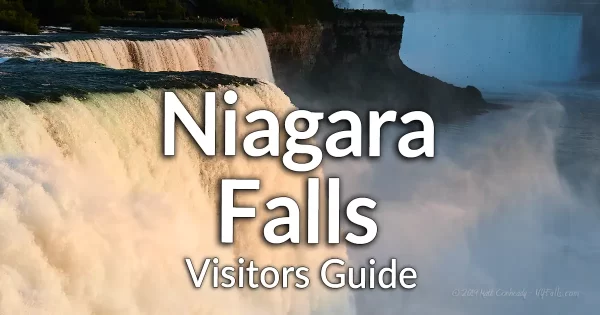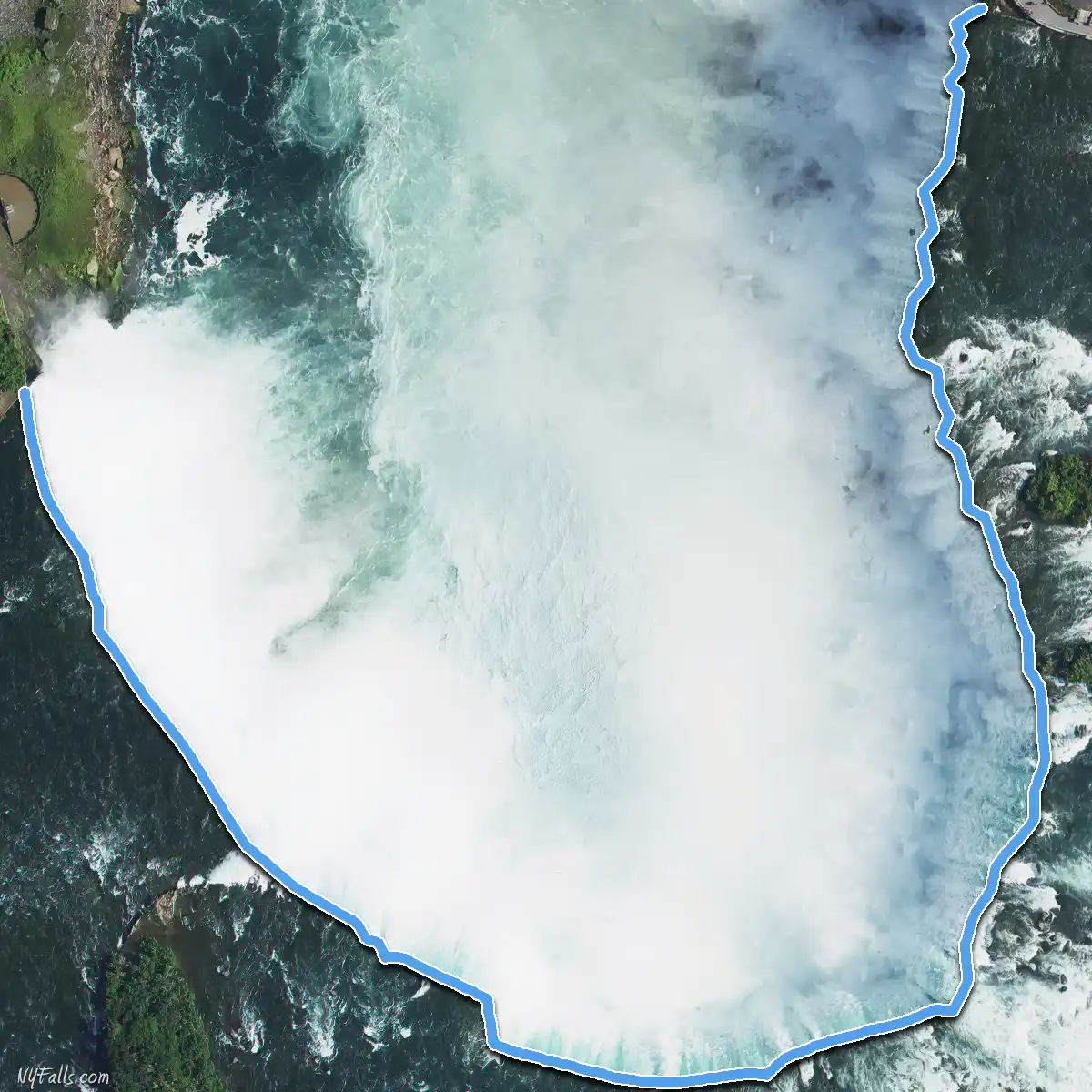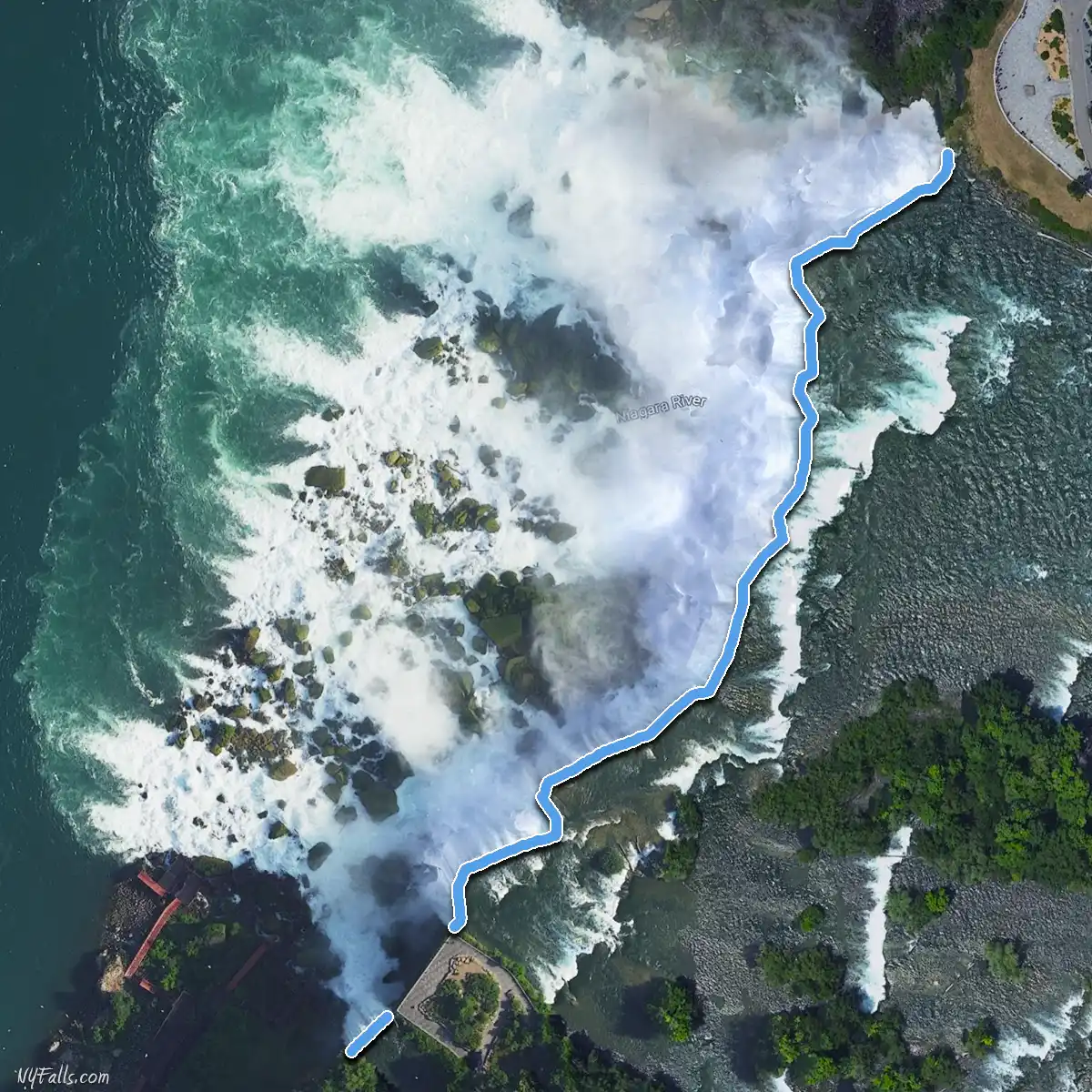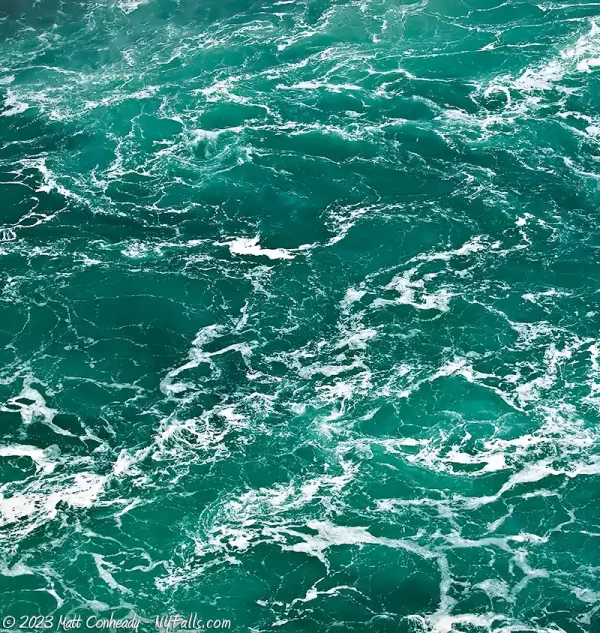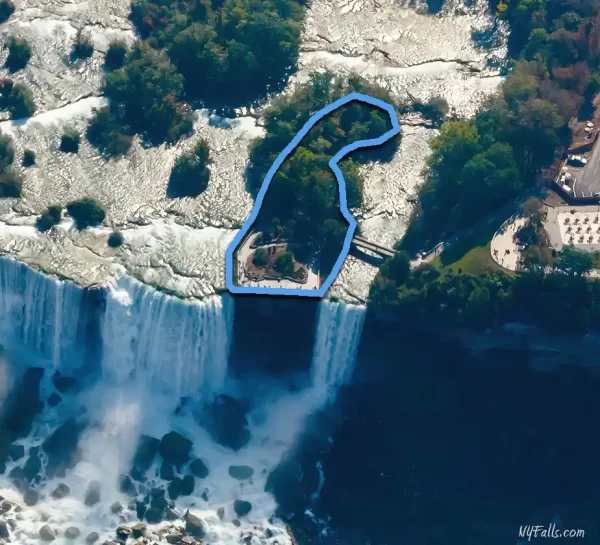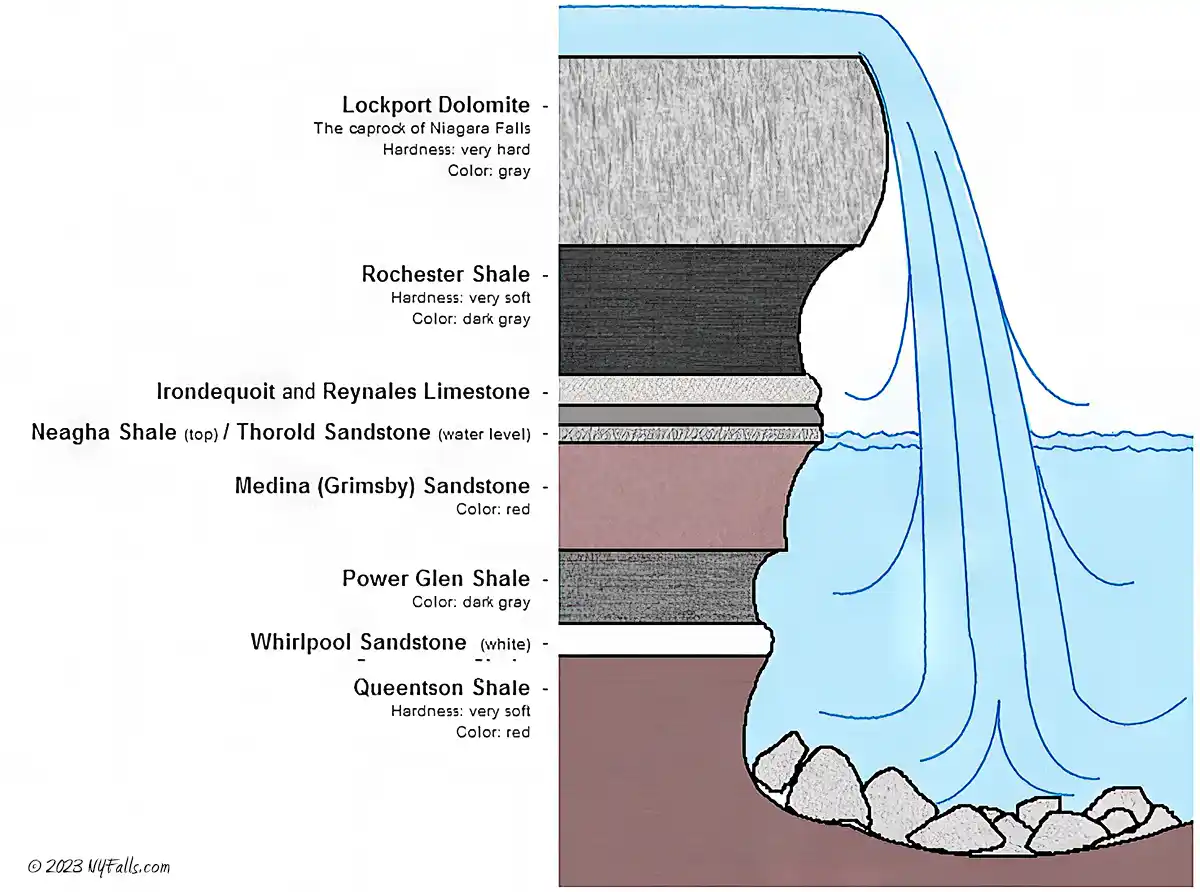Niagara Falls FAQ: Facts & Figures
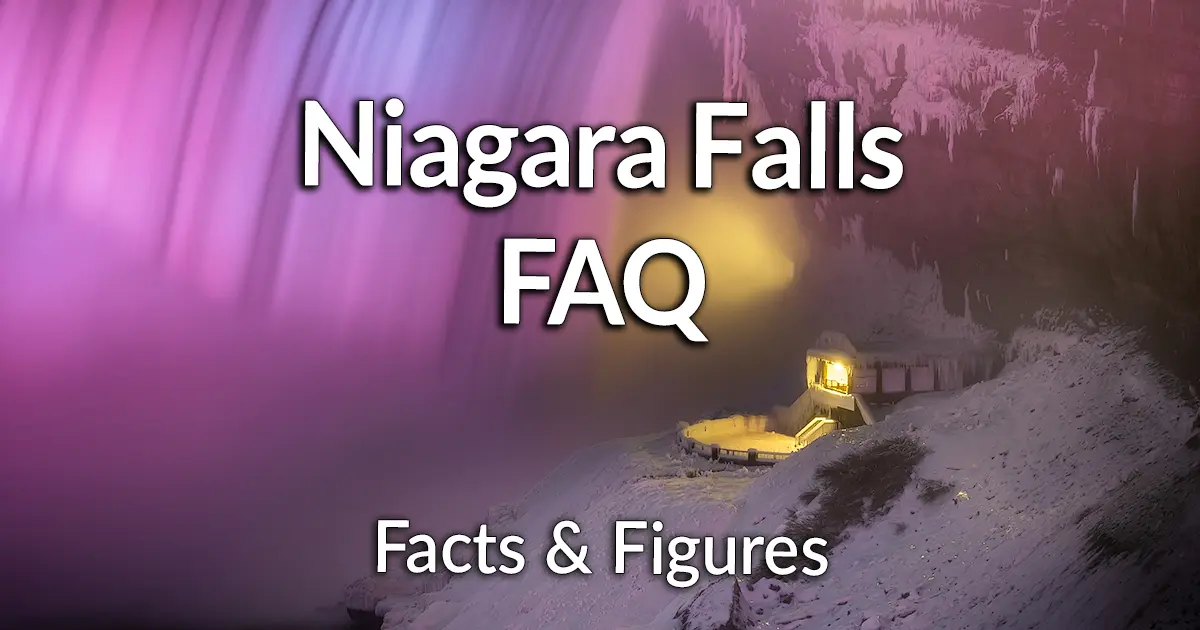
- How tall is Niagara Falls?
- Are Niagara Falls the tallest in the world?
- What shape are the Falls?
- Where does all the water come from?
- How fast does water fall down Niagara Falls?
- Why is the water that shade of blue/green?
- What is that foam below the falls?
- Why do they call it Luna Island?
- What are the rock layers that make up Niagara Falls?
- How loud is Niagara Falls?
- Where did the name ‘Niagara’ come from?
- How old is Niagara Falls?
- Have the Falls ever stopped flowing?
- Has Niagara Falls the Falls ever frozen over?
- Has a boat ever gone over the falls?
- How many people have gone over the falls?
- Why isn’t the “Cave of the Winds” an actual cave?
- How far have the falls moved over time?
- How did they build the first bridge over the Niagara Gorge?
- How much of the water is being diverted for power generation?
- When and where was electricity first generated at Niagara Falls?
- Was electricity discovered at Niagara Falls?
- How many power plants are there at Niagara Falls?
- Which power station is the biggest?
- How do the power plants turn water into electricity?
- How much power is generated by Niagara Falls?
- How has power generation changed the Falls?
- What are those structures upstream from the falls?
- What does the International Control Dam do?
- How many people visit the Falls each year?
- When do they light up the falls?
- When are the fireworks?
- What Casinos are near Niagara Falls?
- What tours of Niagara Falls are available?
- Where can one play Golf at Niagara Falls?
- Where is the best view of Niagara Falls?
- What is the closest viewing area at Niagara Falls?
- How long is the Niagara River?
- What is the elevation difference between Lakes Erie & Ontario?
- When the Niagara River splits around Grand Island, does it become two rivers?
- Where is the Niagara River deepest?
- How did the Niagara Whirlpool form?
- In what direction does the Niagara Whirlpool flow?
- How deep is the water at the Niagara Whirlpool?
- What classes of rapids are in the Niagara River?
- What is Devil’s Hole?
- Where are the Niagara River Gorge walls the tallest?
Niagara Falls Visitors Guide
This Comprehensive Niagara Falls Historic Timeline is a part of our Niagara Falls Guide, a comprehensive look at The Falls, top attractions, and other awesome parks in the region, with a focus on photography and nature.
How tall is Niagara Falls?
If you read several Niagara Falls informational placards, books and visitor’s guides, you’re bound to notice that many of them have different values for the height of the Falls. Which one is correct? Actually, all of them. Since the water flowing over the Falls is highly variable, depending on how much is diverted for power generation as well as seasonal flow, the depth of the water at the crest of the falls, as well as the water level at the pool below can vary, affecting the overall size of the Falls. During peak tourist season, when the Falls see high volumes of water, there is a slight bump in elevation, as the depth of water at the crest increases by several feet, but this is offset greatly by an increase of water in the pool at the base. So as the water flow increases, the height of the fall decreases.
Water flow | American Falls approx. height | Horseshoe Falls approx. height |
Off peak (day/night): | 194 ft (59 m) | 158 ft (48 m) |
Peak tourist season (day): | 183 ft (56 m) | 173 ft (53 m) |
Peak tourist season (night): | 194 ft (59 m) | 158 ft (48 m) |
Full, natural flow: | 168 ft (51 m) | 184 ft (56 m) |
| Source: American Falls International Board | ||
There are several other reasons to consider. Some people measure to the boulders below, which in the case of the American Falls, can reduce the total height significantly. Some measure to the river’s water level in the pool, while others take the distance to the bottom of the pool. Many numbers are rounded, distorted by hearsay, or just estimated incorrectly. Take a look at the diagrams below to get an idea of the size of the falls during a typical summer day:
Canadian (Horseshoe) Falls Measurements
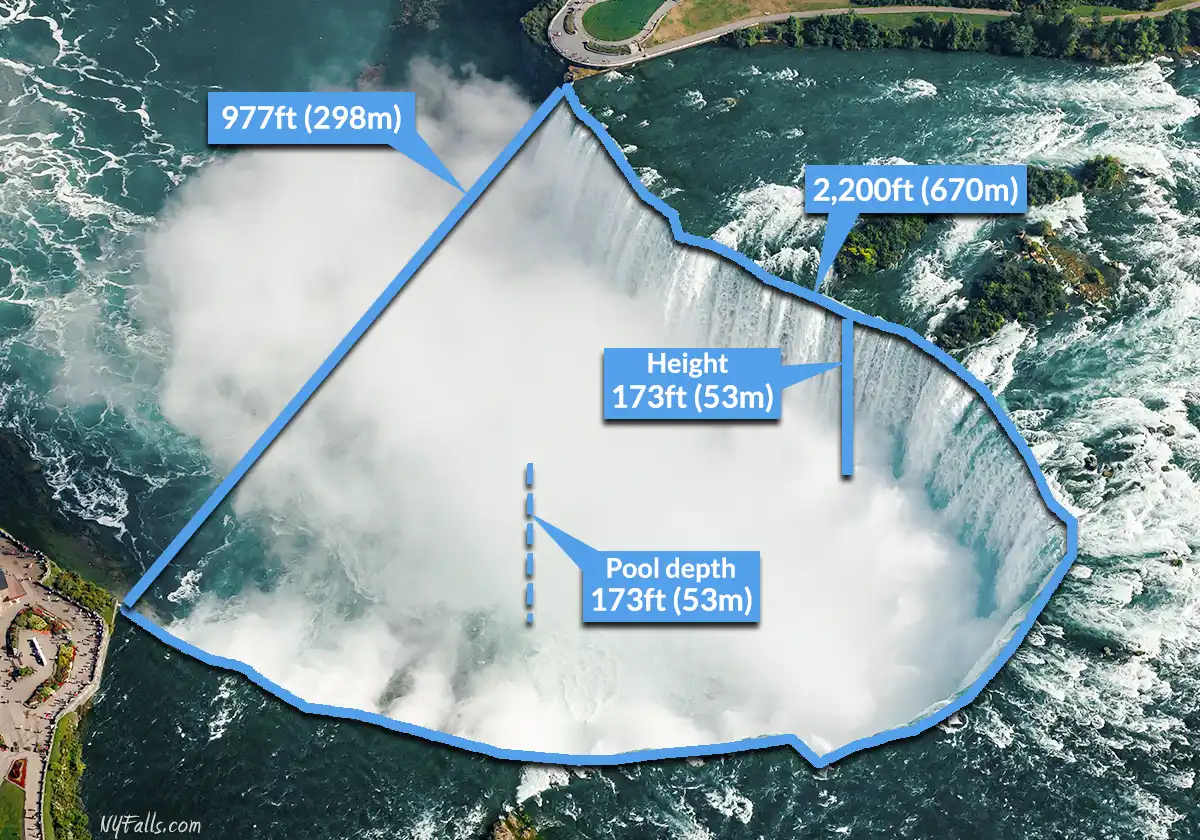
American (Rainbow) Falls Measurements
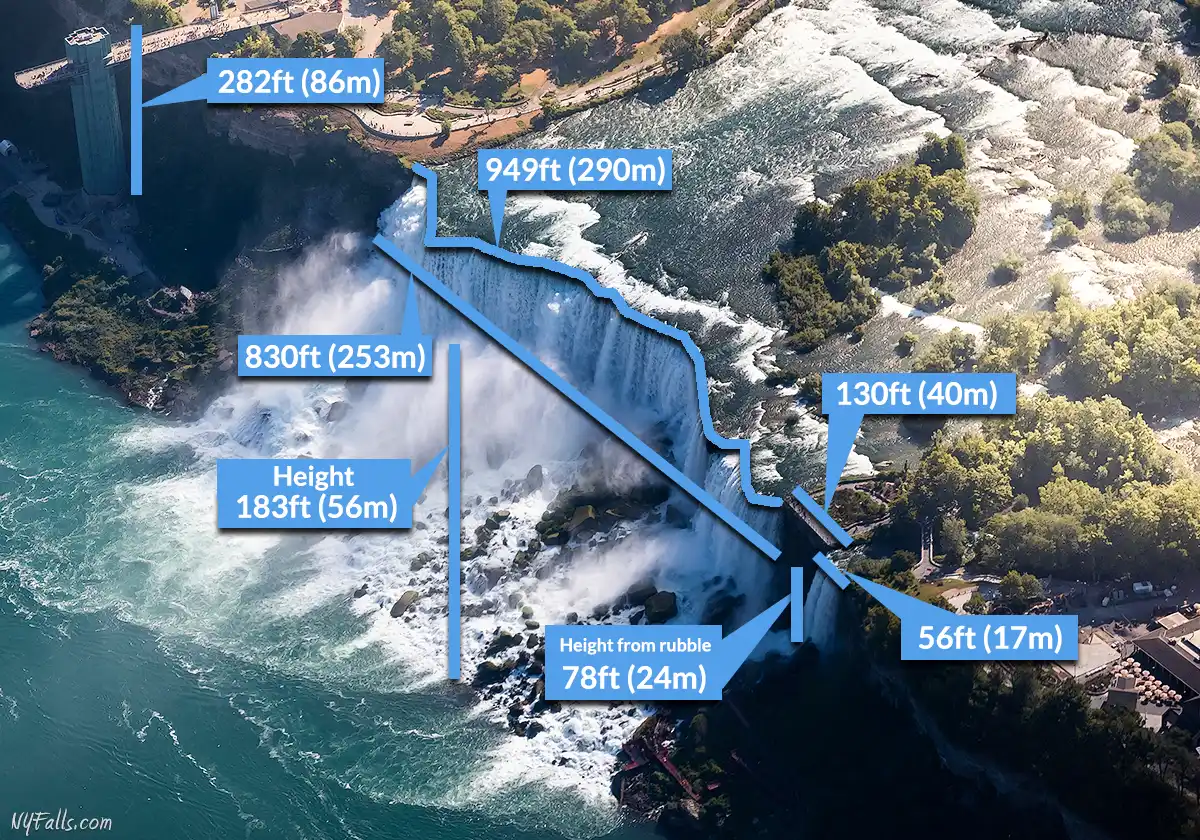
Is Niagara Falls the tallest in the world?
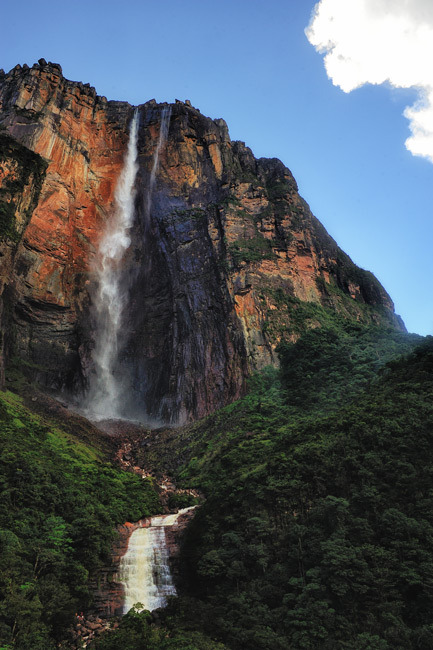 No. Niagara Falls is certainly not the tallest waterfall in the world. That honor goes to Angel Falls in Canaima National Park, Venezuela. Angel Falls drops a total of 3,212 feet (979 meters) down the face of a mountain- that’s 3,029 ft (923 meters) higher than the American Falls! In fact, many waterfalls around the world (at least a thousand) are taller than Niagara Falls.
No. Niagara Falls is certainly not the tallest waterfall in the world. That honor goes to Angel Falls in Canaima National Park, Venezuela. Angel Falls drops a total of 3,212 feet (979 meters) down the face of a mountain- that’s 3,029 ft (923 meters) higher than the American Falls! In fact, many waterfalls around the world (at least a thousand) are taller than Niagara Falls.
Niagara Falls is not even the tallest in the state of NY. Taughannock Falls, near Ithaca, is 32 feet taller. Along the Genesee River Gorge at Letchworth State Park there are six seasonal waterfalls that are at least double the height of Niagara Falls.
Despite these taller waterfalls’ size, they pale in comparison to Niagara when it comes to volume of water. What makes Niagara so grand is its scale. With the largest freshwater system in the world passing over its wide crests, it creates a massive roar. Even with 75% of its water diverted for generating power, it it still an impressive site.
So, is Niagara Falls the largest waterfall in the world?
Taking volume into consideration, Niagara Falls is still not the largest. It ranks in the top 10 in the world, with controversy surrounding which waterfall has the most flow. In the Congo there are a few that have been dubbed the largest in terms of flow- with Inga Falls in the Democratic Republic of the Congo taking the top spot with 1,500,000 cf/s (70,793 cm/s). Although if you are a purist, and require a waterfall to have a significant drop, then Para Falls, on the Caura River in Venezuela would be considered the largest. Its flow reaches 400,000 cf/s (11,327 cm/s) over its 211 ft (64 meter) drop.
If one were to take the total width of Niagara Falls, it may be the widest.
Although Niagara Falls is neither the tallest or largest waterfall in the world, it is the most accessible of the giants. No other waterfall of this size and volume easily allows visitors from around the world to see it from all angles, get close, and even touch it.
What shape are the Falls?
The Horseshoe Falls is shaped like a crude horseshoe, but it wasn’t always this shape. When the first Europeans documented the falls, it seemed to have a shallower curve. In the 1800’s, rock falls began to carve a V-shaped notch in the center of the falls, which led to faster erosion in the center, eventually forming a deeper curve.
Is it really shaped like a horseshoe? Nope.
The American Falls isn’t exactly straight across. It’s more like a zigzag. It also changes from year to year as rocks fall from its face.
Where does all the water come from?
The water that passes over Niagara Falls comes from 4 out of 5 of the Great Lakes: Lake Superior, Michigan, Huron and Erie. With a watershed reaching over 260,000 square miles (673,000 km2), the Great Lakes are the largest fresh water basin in the world. About 2/3 of the fresh water on the continent flows over the Falls – that’s almost 1/5 of the fresh water on Earth.
Where does all this water end up? From the Niagara River, it empties into Lake Ontario and continues east through the St. Lawrence River to the Atlantic Ocean.
Great Lakes Watershed
The diagram below illustrates how the Great Lakes collect water from all over the Great Lakes Basin and channel it from one lake to the next. On the way to Lake Ontario, and eventually the Atlantic Ocean, the water passes through the Niagara River and Niagara Falls.
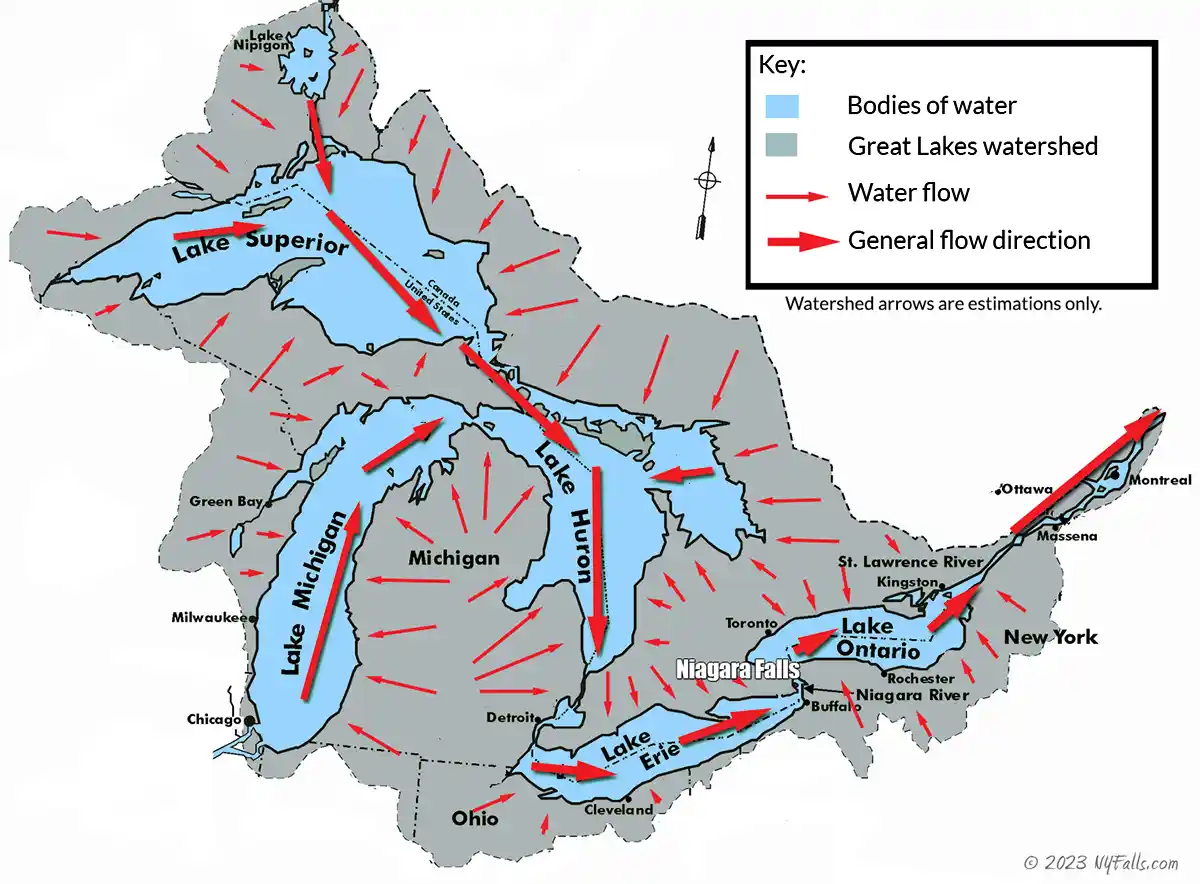
How fast does water fall down Niagara Falls?
Water plummets down the falls at speeds up to 68 miles per hour.
This is the fastest water will travel while in the Niagara River. Water in the rapids above the falls will reach 25 mph. At the Whirlpool, water will reach 35 mph. At Devil’s Hole, the water reaches 22 mph.
What is that foam below the falls?
The answer is quite easy. I’m sure some pollution may contribute to a more foam-friendly river. After all, the millions of residents along the Great Lakes dump thousands of tons of detergents and soaps down their drains each year. Although proper water treatment can drastically reduce this number, some of those everyday household cleaning products eventually make their way, in diluted form, into the Great Lakes and the Niagara River. Although I doubt this is the reason for the clumps of foam that you see below the falls.
What you are seeing is the result of decaying organics.
The same algae plants and diatoms that give the water its fluorescent color also contribute to the grayish foam you see floating on it. The waters of the Niagara, rich in dissolved calcium (in the form of calcium carbonate, from dissolved limestone bedrock) react with the organics in the water (from decaying plant and animal material) creating a sticky substance. The turbulence from the Falls and the rapids creates foam out of it. The foam isn’t very stable and it tends to dissolve within minutes, only to be replenished by more.
Why do they call it Luna Island?
Luna Island, sits on the southern end of the American Falls and is separated from Goat Island by the Bridal Veil Falls. It is approximately 130 feet (40 meters) wide (between the two falls) and 350 feet (107 meters) long. It was at one time called “Young America” by the Porter Family that once owned the land surrounding the American Falls. Since then it has been incorporated into a park, re-vegetated, and in the 1970s reinforced with steel bolts. Although it is not known who dubbed it “Luna Island” and when, we do have a good idea as to why. It is said that Luna Island is the perfect spot to catch a lunar rainbow (or moonbow), a rainbow produced by the light reflected off of the moon.
It this true? Reports around the web have confirmed it. But there’s only one way to make sure. Go there on a full moon and check it out. Here’s a moon phase calendar to help you.
What are the rock layers that make up Niagara Falls?
The layers of rock that comprise the Niagara Gorge at the point of the falls are integral to sustaining a waterfall on the Niagara River. There are several layers of different compositions, colors and hardness; but the bottom line is: the hard, erosion-resistant layer on top and the softer, wear-easy layers on the bottom are what create the falls. As water eats away at the soft rock layers, the tougher cap-rock creates a dramatic overhang for water to plummet from. The rock layers (strata) in this region are all sedimentary rock; rock that was formed by the accumulation and compression of particulates such as sand, silt or minerals. Most of the rock layers of the Niagara Escarpment, over which Niagara Falls plummets, were formed by shallow oceans that once covered the region.
Sedimentary rock types
Although there are numerous rock layers making up Niagara Falls, they are all variations of just a few types of rock.
- Dolomite (dolostone) – A hard rock made of calcium magnesium carbonate (CaMg(CO3)2). Due to its tough crystalline structure, the erosive power of water barely has an effect on it.
- Limestone – A rock made primarily of calcium carbonate (CaCO3). Limestone was formed from prehistoric marine organisms’ shells or coral structures. It dissolves relatively easily in acidic solutions, often forming caves.
- Sandstone – A rock formed from compressed sand (usually quartz and/or feldspar). Generally uniform in color and texture and resistant to weathering.
- Shale (mudstone) –A soft, thin rock formed from compressed mud, clay or silt. Shale is fragile, often splintering into thin irregular sheets. It dissolves easily in water, forming mud or clay.
How Loud is Niagara Falls?
Niagara Falls ranges from 87 to 95 decibels when up close. This is about the same loudness as thunder.
Human conversation is about 65 db. A dog barking is about 75 db.
While I could not find any cases of hearing damage from the falls, the US Department of Labor recommends hearing protection for workers experiencing prolonged noise at 85 db or more. Most visitors to the falls casually come close to the falls for brief periods of time and then move away. If you plan on standing next to them for an extended period of time (hours), and are concerned about your hearing, wearing hearing protection may not be a bad idea. For any average trip to the falls, where you will spend most of your time more than 3 feet away, there should be no problem at all.
Here is an audio sample of Niagara Falls




